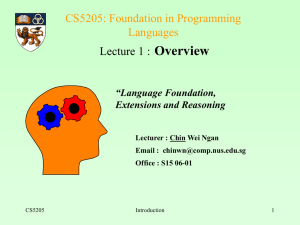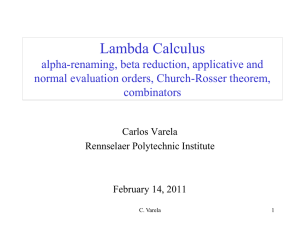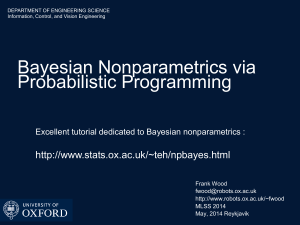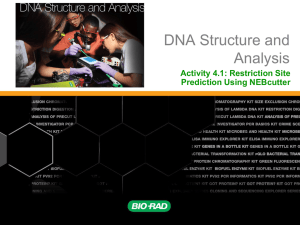Chapter 3
advertisement
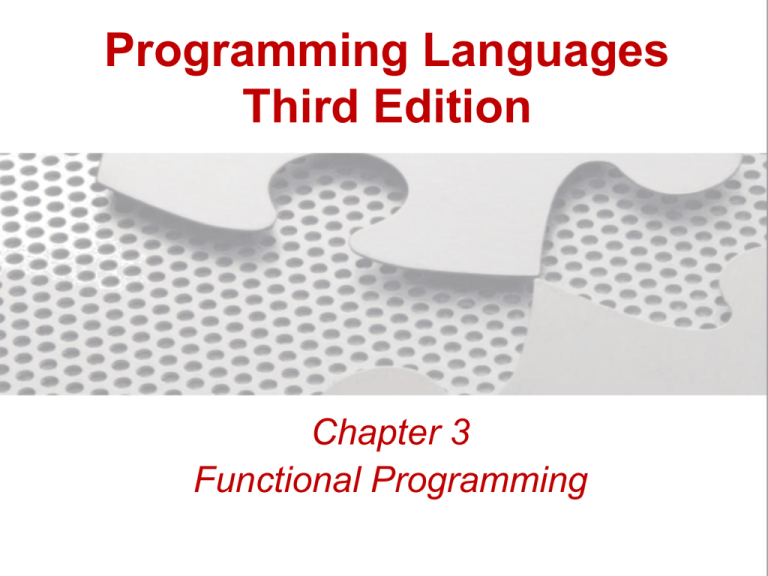
Programming Languages
Third Edition
Chapter 3
Functional Programming
Objectives
• Understand the concepts of functional
programming
• Become familiar with Scheme
• Become familiar with ML
• Understand delayed evaluation
• Become familiar with Haskell
• Understand the mathematics of functional
programming
Programming Languages, Third Edition
2
Background
• Several different styles of programming, including:
– Functional programming
– Logic programming
– Object-oriented programming
• Different languages have evolved to support each
style of programming
– Each type of language rests on a distinct model of
computation, which is different from the von
Neumann model
Programming Languages, Third Edition
3
Background (cont’d.)
• Functional programming:
– Provides a uniform view of programs as functions
– Treats functions as data
– Provides prevention of side effects
• Functional programming languages generally have
simpler semantics and a simpler model of
computation
– Useful for rapid prototyping, artificial intelligence,
mathematical proof systems, and logic applications
Programming Languages, Third Edition
4
Background (cont’d.)
• Until recently, most functional languages suffered
from inefficient execution
– Most were originally interpreted instead of compiled
• Today, functional languages are very attractive for
general programming
– They lend themselves very well to parallel execution
– May be more efficient than imperative languages on
multicore hardware architectures
– Have mature application libraries
Programming Languages, Third Edition
5
Background (cont’d.)
• Despite these advantages, functional languages
have not become mainstream languages for
several reasons:
– Programmers learn imperative or object-oriented
languages first
– OO languages provide a strong organizing principle
for structuring code that mirrors the everyday
experience of real objects
• Functional methods such as recursion, functional
abstraction, and higher-order functions have
become part of many programming languages
Programming Languages, Third Edition
6
Programs as Functions
• A program is a description of specific computation
• If we ignore the “how” and focus on the result, or
the “what” of the computation, the program
becomes a virtual black box that transforms input
into output
– A program is thus essentially equivalent to a
mathematical function
• Function: a rule that associates to each x from set
of X of values a unique y from a set Y of values
Programming Languages, Third Edition
7
Programs as Functions (cont’d.)
• In mathematical terminology, the function can be
written as y=f(x) or f:XY
• Domain of f: the set X
• Range of f: the set Y
• Independent variable: the x in f(x), representing
any value from the set X
• Dependent variable: the y from the set Y, defined
by y=f(x)
• Partial function: occurs when f is not defined for
all x in X
Programming Languages, Third Edition
8
Programs as Functions (cont’d.)
• Total function: a function that is defined for all x in
the set X
• Programs, procedures, and functions can all be
represented by the mathematical concept of a
function
– At the program level, x represents the input, and y
represents the output
– At the procedure or function level, x represents the
parameters, and y represents the returned values
Programming Languages, Third Edition
9
Programs as Functions (cont’d.)
• Functional definition: describes how a value is to
be computed using formal parameters
• Functional application: a call to a defined function
using actual parameters, or the values that the
formal parameters assume for a particular
computation
• In math, there is not always a clear distinction
between a parameter and a variable
– The term independent variable is often used for
parameters
Programming Languages, Third Edition
10
Programs as Functions (cont’d.)
• A major difference between imperative
programming and functional programming is the
concept of a variable
– In math, variables always stand for actual values
– In imperative programming languages, variables
refer to memory locations that store values
• Assignment statements allow memory locations to
be reset with new values
– In math, there are no concepts of memory location
and assignment
Programming Languages, Third Edition
11
Programs as Functions (cont’d.)
• Functional programming takes a mathematical
approach to the concept of a variable
– Variables are bound to values, not memory locations
– A variable’s value cannot change, which eliminates
assignment as an available operation
• Most functional programming languages retain
some notion of assignment
– It is possible to create a pure functional program
that takes a strictly mathematical approach to
variables
Programming Languages, Third Edition
12
Programs as Functions (cont’d.)
• Lack of assignment makes loops impossible
– A loop requires a control variable whose value
changes as the loop executes
– Recursion is used instead of loops
• There is no notion of the internal state of a function
– Its value depends only on the values of its
arguments (and possibly nonlocal variables)
• A function’s value cannot depend on the order of
evaluation of its arguments
– An advantage for concurrent applications
Programming Languages, Third Edition
13
Programs as Functions (cont’d.)
Programming Languages, Third Edition
14
Programs as Functions (cont’d.)
• Referential transparency: the property whereby a
function’s value depends only on the values of its
variables (and nonlocal variables)
• Examples:
– gcd function is referentially transparent
– rand function is not because it depends on the state
of the machine and previous calls to itself
• A referentially transparent function with no
parameters must always return the same value
– Thus it is no different than a constant
Programming Languages, Third Edition
15
Programs as Functions (cont’d.)
• Referential transparency and the lack of
assignment make the semantics straightforward
• Value semantics: semantics in which names are
associated only to values, not memory locations
• Lack of local state in functional programming
makes it opposite of OO programming, wherein
computation proceeds by changing the local state
of objects
• In functional programming, functions must be
general language objects, viewed as values
themselves
Programming Languages, Third Edition
16
Programs as Functions (cont’d.)
• In functional programming, functions are firstclass data values
– Functions can be computed by other functions
– Functions can be parameters to other functions
• Composition: essential operation on functions
– A function takes two functions as parameters and
produces another function as its returned value
• In math, the composition operator o is defined:
If f:XY and g:YZ, then g o f:XZ is given by
(g o f)(x) = g(f(x))
Programming Languages, Third Edition
17
Programs as Functions (cont’d.)
• Qualities of functional program languages and
functional programs:
– All procedures are functions that distinguish
incoming values (parameters) from outgoing values
(results)
– In pure functional programming, there are no
assignments
– In pure functional programming, there are no loops
– Value of a function depends only on its parameters,
not on order of evaluation or execution path
– Functions are first-class data values
Programming Languages, Third Edition
18
Scheme: A Dialect of Lisp
• Lisp (LISt Processing): first language that
contained many of the features of modern
functional languages
– Based on the lambda calculus
• Features included:
– Uniform representation of programs and data using
a single general structure: the list
– Definition of the language using an interpreter
written in the same language (metacircular
interpreter)
– Automatic memory management by the runtime
system
Programming Languages, Third Edition
19
Scheme: A Dialect of Lisp (cont’d.)
• No single standard evolved for Lisp, and there are
many variations
• Two dialects that use static scoping and a more
uniform treatment of functions have become
standard:
– Common Lisp
– Scheme
Programming Languages, Third Edition
20
The Elements of Scheme
• All programs and data in Scheme are considered
expressions
• Two types of expressions:
– Atoms: like literal constants and identifiers of an
imperative language
– Parenthesized expression: a sequence of zero or
more expressions separated by spaces and
surrounded by parentheses
• Syntax is expressed in extended Backus-Naur
form notation
Programming Languages, Third Edition
21
The Elements of Scheme (cont’d.)
Programming Languages, Third Edition
22
The Elements of Scheme (cont’d.)
• Syntax of Scheme:
expression atom | ‘(‘ {expression} ’)’
atom number | string | symbol |
character | boolean
• When parenthesized expressions are viewed as
data, they are called lists
• Evaluation rule: the meaning of a Scheme
expression
• An environment in Scheme is a symbol table that
associates identifiers with values
Programming Languages, Third Edition
23
The Elements of Scheme (cont’d.)
• Standard evaluation rule for Scheme expressions:
– Atomic literals evaluate to themselves
– Symbols other than keywords are treated as
identifiers or variables that are looked up in the
current environment and replaced by values found
there
– A parenthesized expression or list is evaluated in
one of two ways:
• If the first item is a keyword, a special rule is applied
to evaluate the rest of the expression
• An expression starting with a keyword is called a
special form
Programming Languages, Third Edition
24
The Elements of Scheme (cont’d.)
• Otherwise, the parenthesized expression is a function
application
• Each expression within the parentheses is evaluated
recursively
• The first expression must evaluate to a function, which
is then applied to remaining values (its arguments)
• The Scheme evaluation rule implies that all
expressions must be written in prefix form
– Example: (+ 2 3)
• + is a function, and it is applied to the values 2 and 3,
to return the value 5
Programming Languages, Third Edition
25
The Elements of Scheme (cont’d.)
• Evaluation rule also implies that the value of a
function (as an object) is clearly distinguished from
a call to the function
– Function is represented by the first expression in an
application
– Function call is surrounded by parentheses
• Evaluation rule represents applicative order
evaluation:
– All subexpressions are evaluated first
– A corresponding expression tree is evaluated from
leaves to root
Programming Languages, Third Edition
26
The Elements of Scheme (cont’d.)
Programming Languages, Third Edition
27
The Elements of Scheme (cont’d.)
• Example: (* (+ 2 3) (+ 4 5 ))
– Two additions are evaluated first, then the
multiplication
Programming Languages, Third Edition
28
The Elements of Scheme (cont’d.)
• A problem arises when data are represented
directly in a program, such as a list of numbers
• Example: (2.1 2.2 3.1)
– Scheme will try to evaluate it as a function call
– Must prevent this and consider it to be a list literal,
using a special form with the keyword quote
• Example: (quote (2.1 2.2 3.1))
• Rule for evaluating a quote special form is to
simply return the expression following quote
without evaluating it
Programming Languages, Third Edition
29
The Elements of Scheme (cont’d.)
• Loops are provided by recursive call
• Selection is provided by special forms:
– if form: like an if-else construct
– cond form: like an if-elseif construct; cond
stands for conditional expression
Programming Languages, Third Edition
30
The Elements of Scheme (cont’d.)
• Neither the if nor the cond special form obey the
standard evaluation rule
– If they did, all arguments would be evaluated each
time, rendering them useless as control mechanisms
– Arguments to special forms are delayed until the
appropriate moment
• Scheme function applications use pass by value,
while special forms in Scheme and Lisp use
delayed evaluation
Programming Languages, Third Edition
31
The Elements of Scheme (cont’d.)
• Special form let: binds a variable to a value within
an expression
– Example: (let ((a 2) (b 3)) (+ 1 b))
• First expression in a let is a binding list
• let provides a local environment and scope for a
set of variable names
– Similar to temporary variable declarations in blockstructured languages
– Values of the variables can be accessed only within
the let form, not outside it
Programming Languages, Third Edition
32
The Elements of Scheme (cont’d.)
• lambda special form: creates a function with the
specified formal parameters and a body of code to
be evaluated when the function is applied
– Example:
(lambda (radius) (* 3.14 (* radius radius)))
– Can apply the function to an argument by wrapping it
and the argument in another set of parentheses:
((lambda (radius) (* 3.14 (* radius radius)))
10)
Programming Languages, Third Edition
33
The Elements of Scheme (cont’d.)
• Can bind a name to a lambda within a let:
(let ((circlearea (lambda (radius) (* 3.14 (*
radius radius))))) (circlearea 10))
• let cannot be used to define recursive functions
since let bindings cannot refer to themselves or
each other
• letrec special form: works like a let but allows
arbitrary recursive references within the binding list
(letrec ((factorial (lambda (n) (if (= n 0) 1
(* n (factorial (- n 1))))))) (factorial 10)
Programming Languages, Third Edition
34
The Elements of Scheme (cont’d.)
• let and letrec forms create variables visible
within the scope and lifetime of the let or letrec
• define special form: creates a global binding of a
variable visible in the top-level environment
Programming Languages, Third Edition
35
Dynamic Type Checking
• Scheme’s semantics include dynamic or latent type
checking
– Only values, not variables, have data types
– Types of values are not checked until necessary at
runtime
• Automatic type checking happens right before a
primitive function, such as +
• Arguments to programmer-defined functions are
not automatically checked
• If wrong type, Scheme halts with an error message
Programming Languages, Third Edition
36
Dynamic Type Checking (cont’d.)
• Can use built-in type recognition functions such as
number? and procedure? to check a value’s type
– This slows down programmer productivity and the
code’s execution speed
Programming Languages, Third Edition
37
Tail and Non-Tail Recursion
• Because of runtime overhead for procedure calls,
loops are always preferable to recursion in
imperative languages
• Tail recursive: when the recursive steps are the
last steps in any function
– Scheme compiler translates this to code that
executes as a loop with no additional overhead for
function calls other than the top-level call
– Eliminates the performance hit of recursion
Programming Languages, Third Edition
38
Tail and Non-Tail Recursion (cont’d.)
Programming Languages, Third Edition
39
Tail and Non-Tail Recursion (cont’d.)
• Non-tail recursive function example in Figure 3.4:
– After each recursive call, the value returned by the
call must be multiplied by n (the argument to the
previous call)
– Requires a runtime stack to track the value of this
argument for each call as the recursion unwinds
– Entails a linear growth of memory and a substantial
performance hit
Programming Languages, Third Edition
40
Tail and Non-Tail Recursion (cont’d.)
• Tail recursive function example in Figure 3.4:
– All the work of computing values is done when the
arguments are evaluated before each recursive call
– Argument result is used to accumulate intermediate
products on the way down through the recursive
calls
– No work remains to be done after each recursive
call, so no runtime stack is necessary to remember
arguments of previous calls
Programming Languages, Third Edition
41
Data Structures in Scheme
• Basic data structure in Scheme is the list
– Can represent a sequence, a record, or any other
structure
• Scheme also supports structured types for vectors
(one-dimensional arrays) and strings
• List functions:
– car: accesses the head of the list
– cdr: returns the tail of the list (minus the head)
– cons: adds a new head to an existing list
Programming Languages, Third Edition
42
Data Structures in Scheme (cont’d.)
• Example: a list representation of a binary search
tree
("horse" ("cow" () ("dog" () ()))
("zebra" ("yak" () ()) () ))
• A tree node is a list of three items (name left right)
Programming Languages, Third Edition
43
Data Structures in Scheme (cont’d.)
• List can be visualized as a pair of values: the car
and the cdr
– List L is a pointer to a box of two pointers, one to its
car and the other to its cdr
Programming Languages, Third Edition
44
Data Structures in Scheme (cont’d.)
• Box and pointer notation for a simple list (1 2 3)
– Black rectangle in the end box stands for the empty
list ( )
Programming Languages, Third Edition
45
Data Structures in Scheme (cont’d.)
Programming Languages, Third Edition
46
Data Structures in Scheme (cont’d.)
• All the basic list manipulation operations can be
written as functions using the primitives car, cdr,
cons, and null?
– null? returns true if the list is empty or false
otherwise
Programming Languages, Third Edition
47
Programming Techniques in Scheme
• Scheme relies on recursion to perform loops and
other repetitive operations
– To apply repeated operations to a list, “cdr down and
cons up”: apply the operation recursively to the tail of
a list and then use the cons operator to construct a
new list with the current result
• Example:
(define square-list (lambda (L)
(if (null? L) '()
(cons (* (car L) (car L)) (square-list
(cdr L)))))
Programming Languages, Third Edition
48
Higher-Order Functions
• Higher-order functions: functions that take other
functions as parameters and functions that return
functions as values
• Example: function with a function parameter that
returns a function value
(define make-double (lambda (f)
(lambda (x) (f x x)))
• Can now create functions using this:
(define square (make-double *))
(define double (make-double +))
Programming Languages, Third Edition
49
Higher-Order Functions (cont’d.)
• Runtime environment of functional languages is
more complicated than the stack-based
environment of a standard block-structured
imperative language
• Garbage collection: automatic memory
management technique to return memory used by
functions
Programming Languages, Third Edition
50
Static (Lexical) Scoping
• Early dialects of Lisp were dynamically scoped
• Modern dialects, including Scheme and Common
Lisp, are statically scoped
• Static scope (or lexical scope): the area of a
program in which a variable declaration is visible
– For static scoping, the meaning or value of a
variable can be determined by reading the source
code
– For dynamic scoping, the meaning depends on the
runtime context
Programming Languages, Third Edition
51
Static (Lexical) Scoping (cont’d.)
• Declaration of variables can be nested in blockstructured languages
• Scope of a variable extends to the end of the block
in which it is declared, including any nested blocks
(unless it is redeclared within a nesting block)
Programming Languages, Third Edition
52
Static (Lexical) Scoping (cont’d.)
• Free variable: a variable referenced within a
function that is not also a formal parameter to that
function and is not bound within a nested function
• Bound variable: a variable within a function that is
also a formal parameter to that function
• Lexical scoping fixes the meaning of free variables
in one place in the code, making a program easier
to read and verify than dynamic scoping
Programming Languages, Third Edition
53
Symbolic Information Processing
and Metalinguistic Power
• Metalinguistic power: the capacity to build,
manipulate, and transform lists of symbols that are
then evaluated as programs
• Example: let form is actually syntactic sugar for
the application of a lambda form to its arguments
Programming Languages, Third Edition
54
Delayed Evaluation
• In a language with an applicative order evaluation
rule, all parameters to user-defined functions are
evaluated at the time of a call
• Examples that do not use applicative order
evaluation:
– Boolean special forms and and or
– if special form
• Short-circuit evaluation of Boolean expressions
allows a result without evaluating the second
parameter
Programming Languages, Third Edition
55
Delayed Evaluation (cont’d.)
• Delayed evaluation is necessary for if special
form
• Example: (if a b c)
– Evaluation of b and c must be delayed until the
result of a is known; then either b or c is evaluated,
but not both
• Must distinguish between forms that use standard
evaluation (function applications) and those that do
not (special forms)
• Using applicative order evaluation for functions
makes semantics and implementation easier
Programming Languages, Third Edition
56
Delayed Evaluation (cont’d.)
• Nonstrict: a property of a function in which
delayed evaluation leads to a well-defined result,
even though subexpressions or parameters may be
undefined
• Languages with the property that functions are
strict are easier to implement, although
nonstrictness can be a desirable property
• Algol60 included delayed execution in its pass by
name parameter passing convention
– A parameter is evaluated only when it is actually
used in the code of a called procedure
Programming Languages, Third Edition
57
Delayed Evaluation (cont’d.)
• Example: Algol60 delayed execution
• When called as p(true, 1 div 0), it returns 1
since y is never reached in the code of p
– The undefined expression 1 div 0 is never
computed
Programming Languages, Third Edition
58
Delayed Evaluation (cont’d.)
• In a language with function values, it is possible to
delay evaluation of a parameter by enclosing it in a
function “shell” (a function with no parameters)
• Example: C pass by name equivalent
Programming Languages, Third Edition
59
Delayed Evaluation (cont’d.)
• Such “shell” procedures are sometimes referred to
as pass by name thunks, or just thunks
• In Scheme and ML, the lambda and fn function
value constructors can be used to surround
parameters with function shells
• Example:
which can be called as follows:
Programming Languages, Third Edition
60
Delayed Evaluation (cont’d.)
• delay special form: delays evaluation of its
arguments and returns an object like a lambda
“shell” or promise to evaluate its arguments
• force special form: causes its parameter, a
delayed object, to be evaluated
• Previous function can now be written as:
and called as:
Programming Languages, Third Edition
61
Delayed Evaluation (cont’d.)
• Delayed evaluation can introduce inefficiency when
the same delayed expression is repeatedly
evaluated
• Scheme uses a memoization process to store the
value of the delayed object the first time it is forced
and then return this value for each subsequent call
to force
– This is sometimes referred to as pass by need
Programming Languages, Third Edition
62
Delayed Evaluation (cont’d.)
• Lazy evaluation: only evaluate an expression once
it is actually needed
• This can be achieved in a functional language
without explicit calls to delay and force
• Required runtime rules for lazy evaluation:
– All arguments to user-defined functions are delayed
– All bindings of local names in let and letrec
expressions are delayed
– All arguments to constructor functions are delayed
Programming Languages, Third Edition
63
Delayed Evaluation (cont’d.)
• Required runtime rules for lazy evaluation (cont’d.):
– All arguments to other predefined functions are
forced
– All function-valued arguments are forced
– All conditions in selection forms are forced
• Lists that obey lazy evaluation may be called
streams
• Primary example of a functional language with lazy
evaluation is Haskell
Programming Languages, Third Edition
64
Delayed Evaluation (cont’d.)
• Generator-filter programming: a style of
functional programming in which computation is
separated into procedures that generate streams
and other procedures that take streams as
arguments
• Generators: procedures that generate streams
• Filters: procedures that modify streams
• Same-fringe problem for lists: two lists have the
same fringe if they contain the same non-null
atoms in the same order
Programming Languages, Third Edition
65
Delayed Evaluation (cont’d.)
• Example: these lists have the same fringe:
((2 (3)) 4) and (2 (34 ()))
• To determine if two lists have the same fringe,
must flatten them to just lists of their atoms
• flatten function: can be viewed as a filter;
reduces a list to a list of its atoms
• Lazy evaluation will compute only enough of the
flattened lists as necessary before their elements
disagree
Programming Languages, Third Edition
66
Delayed Evaluation (cont’d.)
• Delayed evaluation complicates the semantics and
increases complexity in the runtime environment
– Delayed evaluation has been described as a form of
parallelism, with delay as a form of process
suspension and force as a kind of process
continuation
• Side effects, in particular assignment, do not mix
well with lazy evaluation
Programming Languages, Third Edition
67
The Mathematics of Functional
Programming: Lambda Calculus
• Lambda calculus: invented by Alonzo Church in
the 1930s
– A mathematical formalism for expressing
computation by functions
– Can be used as a model for purely functional
programming languages
• Many functional languages, including Lisp, ML and
Haskell, were based on lambda calculus
Programming Languages, Third Edition
68
Lambda Calculus (cont’d.)
• Lambda abstraction: the essential construct of
lambda calculus:
• Can be interpreted exactly as this Scheme lambda
expression:
– An unnamed function of parameter x that adds 1 to
x
• Basic operation of lambda calculus is the
application of expressions such as the lambda
abstraction
Programming Languages, Third Edition
69
Lambda Calculus (cont’d.)
• This expression:
– Represents the application of the function that adds
1 to x to the constant 2
• A reduction rule permits 2 to be substituted for x
in the lambda, yielding this:
Programming Languages, Third Edition
70
Lambda Calculus (cont’d.)
• Syntax for lambda calculus:
• Third rule represents function application
• Fourth rule gives lambda abstractions
• Lambda calculus as defined here is fully curried
Programming Languages, Third Edition
71
Currying
• Lambdas can only describe functions of a single variable
– (λn.(λm. …))
– A wrong example:
(λn m. if m = 0 then n else …))
• Currying: the process of splitting multiple parameters into single
parameters to higher-order functions
– The general principle
fname :: (type1, type2) -> type3 =>
fname :: type1 -> type2 -> type3
– e.g.,
(+ 2 3) => ((+ 2) 3)
CS4303 Hong72Lin
Lambda Calculus (cont’d.)
• Lambda calculus variables do not occupy memory
• The set of constants and the set of variables are
not specified by the grammar
– It is more correct to speak of many lambda calculi
• In the expression
– x is bound by the lambda
– The expression E is the scope of the binding
– Free occurrence: any variable occurrence outside
the scope
– Bound occurrence: an occurrence that is not free
Programming Languages, Third Edition
73
Lambda Calculus (cont’d.)
• Different occurrences of a variable can be bound
by different lambdas
• Some occurrences of a variable may be bound,
while others are free
• Can view lambda calculus as modeling functional
programming:
– A lambda abstraction as a function definition
– Juxtaposition of two expressions as function
application
Programming Languages, Third Edition
74
Bound and free variables
• (λx.E)
– The scope of the binding of the lambda is expression
E
– All occurrences of x in E are bound
– All occurrences of x outside E are not bound by this
lambda
• e.g., in (λx. + y x)
– x is bound, like a local variable
– y is free, like a nonlocal reference in the function
CS4303 Hong75Lin
Lambda Calculus (cont’d.)
• Typed lambda calculus: more restrictive form that
includes the notion of data type, thus reducing the
set of expressions that are allowed
• Precise rules must be given for transforming
expressions
• Substitution (or function application): called
beta-reduction in lambda calculus
• Beta-abstraction: reversing the process of
substitution
• Beta-conversion: either beta-reduction or betaabstraction
Programming Languages, Third Edition
76
Lambda Calculus (cont’d.)
• Name capture problem: when doing betaconversion and replacing variables that occur in
nested scopes, an incorrect reduction may occur
– Must change the name of the variable in the inner
lambda abstraction (alpha-conversion)
• Eta-conversion: allows for the elimination of
“redundant” lambda abstractions
– Helpful in simplifying curried definitions in functional
languages
Programming Languages, Third Edition
77
Beta-abstraction and beta-reduction
• beta-reduction
((λx. + x 1) 2) => (+ 2 1)
• beta-abstraction
(+ 2 1) => ((λx. + x 1) 2)
• beta-conversion (-conversion) - betaabstraction or beta reduction
((λx. E) F) <=> E[F/x]
where E[F/x] is E with all free occurrences of x
replaced by F
CS4303 Hong78Lin
Alpha-conversion (-conversion)
• The name capture problem: if you substitute an
expression with free variables into a lambda, one or
more of those free variables may conflict with names
bound by lambdas (and be captured by them), giving
incorrect results (since variable bound/free status
should not change)
((λx.(λy. + x y)) y) => (λy. + y y)
• alpha-conversion
– General form: (λx. E) <=> (λy. E[y/x]) and y does not occur in
E
– ((λx.(λy. + x y)) y) =>
((λx.(λz. + x z)) y) =>
(λz. + y z)
CS4303 Hong79Lin
Eta-conversion (-conversion)
• The process of eliminating redundant lambda
abstractions
(λx. (E x)) <=> E if E contains no free occurrences of x
• e.g.,
– (λx. (+ 1 x)) => (+ 1)
– (λx.(λy.(+ x y))) => (λx. (+ x)) => +
CS4303 Hong80Lin
Lambda Calculus (cont’d.)
• Applicative order evaluation (pass by value) vs.
normal order evaluation (pass by name)
• Example: evaluate this expression:
– Use applicative order; replacing (1 2 3) by its value
and then applying beta-reduction gives:
– Use normal order; applying beta-reduction first and
then evaluating gives:
• Normal order evaluation is a kind of delayed
evaluation
Programming Languages, Third Edition
81
Lambda Calculus (cont’d.)
• Different results can occur, such as when
parameter evaluation gives an undefined result
– Normal order will still compute the correct value
– Applicative order will give an undefined result
• Functions that can return a value even when
parameters are undefined are said to be nonstrict
• Functions that are undefined when parameters are
undefined are said to be strict
• Church-Rosser theorem: reduction sequences
are essentially independent of the order in which
they are performed
Programming Languages, Third Edition
82
Semantics
• An expression is a normal form if there are no
-reductions that can be performed on it.
• The semantics of an expression in lambda
calculus is expressed by converting it to a
normal form, if possible. Such a normal form,
if it exists, is unique, by the famous ChurchRosser Theorem.
• Not all reduction sequences lead to a normal
form: ( y. 2) (( x. x x)( x. x x))
CS4303 Hong83Lin
Lambda Calculus (cont’d.)
• Fixed point: a function that when passed to
another function as an argument returns a function
• To define a recursive function in lambda calculus,
we need a function Y for constructing a fixed point
of the lambda expression for the function
– Y is called a fixed-point combinator
• Because by its nature, Y will actually construct a
solution that is in some sense the “smallest”; one
can refer to the least-fixed-point semantics of
recursive functions in lambda calculus
Programming Languages, Third Edition
84

